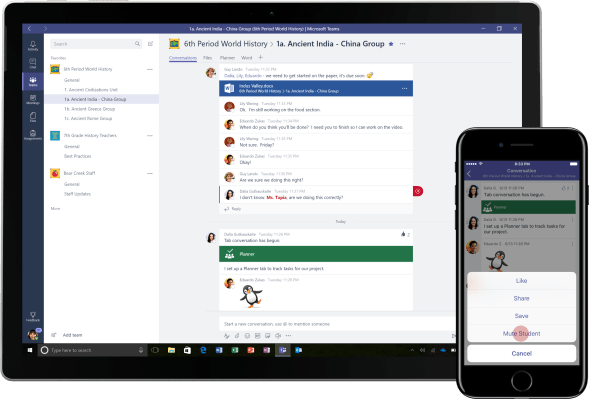Microsoft Teams, the company’s team collaboration software and challenger to Slack, announced this morning — on its first anniversary — a suite of new features that will roll out to the software throughout 2018. This includes features that will allow users to record, transcribe and save meetings to the cloud, integrations with voice assistant Cortana, inline message translation and several others.
The added integration with Cortana’s voice assistance could give Microsoft an edge in its battle with Slack, given the increasing importance of voice-based computing in the workplace and within business productivity applications.
Microsoft and Amazon announced last year their voice assistants, Cortana and Alexa, would work together, for example. Meanwhile, companies — including Microsoft — have been working to make their applications and services work well with voice assistants given the potential of voice computing in the workplace.
According to Microsoft, Cortana voice integrations for Teams-enabled devices will launch later this year, allowing users to easily make a call, join a meeting or add people to meetings using natural, spoken language. What’s more, these voice capabilities will extend to IP phones and conference room devices, as well.
This feature alone could be a big selling point for Microsoft Teams, but it’s one of several the company announced are in the works.
Also coming in 2018 is cloud recording — another that takes advantages of advances in voice technology in recent years. Microsoft Teams will be able to record meetings with a click, then create an automatic transcription of what was said. Meeting attendees can choose to play back the meeting in full, or just a key part, using the transcription as reference.
This feature will also be advanced in the future to include facial recognition, so meeting remarks can be properly attributed.
Meeting transcription is an area other startups are working in, as well. For example, recently launched Otter is offering an automatic transcription tool for meetings, as is Voicera, which just landed $20 million for its automated note-taking assistant. (It wouldn’t be surprising to see Slack snatch up a company like this in the future, to help it compete by way of native voice and transcription features.)
Microsoft is also promising inline messaging translations between languages in channels and chat; a background blur option for video calls (great for meetings from home offices); proximity detection for adding available Skype Room Systems to meetings; and mobile sharing in meetings.
This last item will allow attendees to share a live video stream, photo or screen share from their mobile device.
In addition to the planned features, Microsoft announced new enterprise-grade calling features arriving today, including consultative transfer and call delegation and federation. It’s also now rolling out Direct Routing, which allows customers to integrate existing telephony infrastructure with Teams for calling.

Related to this, Teams is also now enabled across meeting room devices, including Microsoft Surface Hub; devices from new partners Lenovo and HP (which join Logitech, Crestron and Polycom); Skype Room Systems; new solutions from BlueJeans, Pexip and Polycom that will connect with Teams; new desk phones from AudioCodes and Yealink and new conference room phones from Crestron, Polycom and Yealink, all of which will run a native Teams app; and new mobile phone stations from Plantronics.
Microsoft today gave an update on Teams’ traction, given it’s now been a year since its worldwide debut. There are today 200,000 organizations in 181 markets and 39 languages on Teams, including A.P. Moller-Maersk, ConocoPhillips, Macy’s, NASCAR, Navistar, RLH Corporation and Technicolor and, as of another announcement today, General Motors.
By comparison, Slack reports 9 million weekly active users across 50,000+ paying companies in over 100 countries, according to stats on its website. It said in September it had grown to more than 6 million daily users, as well.
